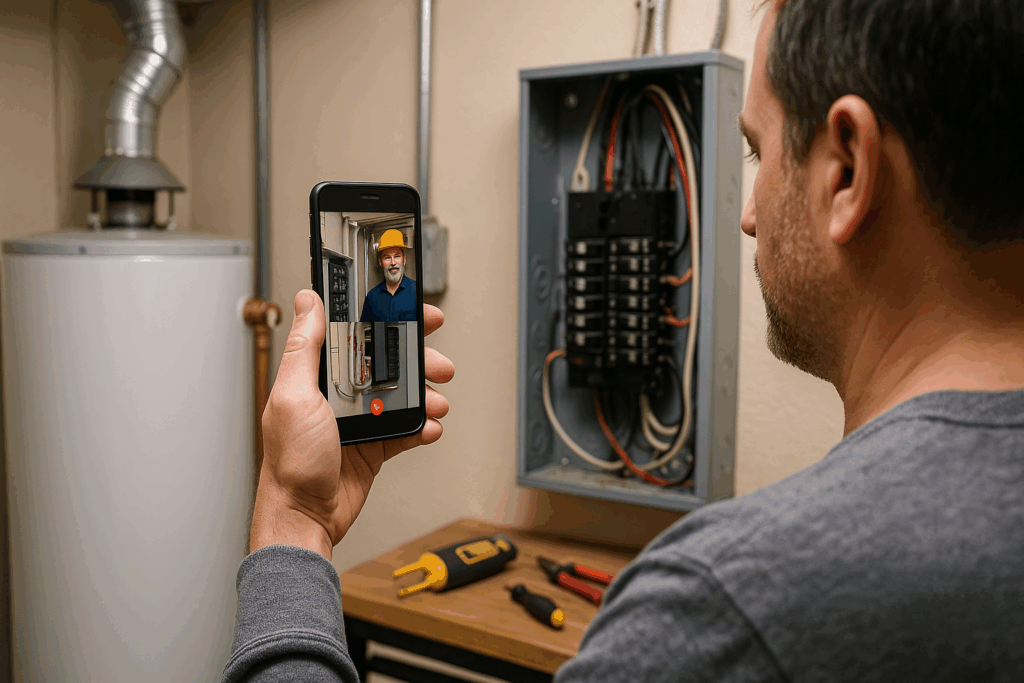Imagine this: You’re knee-deep in a plumbing project, staring at a strange valve that wasn’t in the YouTube tutorial. Instead of tearing it out—or calling it quits—you grab your phone, video chat a pro, and fix it together. Welcome to the age of contractor remote troubleshooting, where expert help is just a screen away.
This isn’t the future. It’s happening now, and it’s revolutionizing how DIYers approach tricky repairs.
What Is Contractor Remote Troubleshooting?
A Pro in Your Pocket
Contractor remote troubleshooting lets you connect with licensed pros via video call, photo uploads, or chat. Instead of waiting days for someone to show up, you get instant advice tailored to your exact issue.
Here’s how it typically works:
- You schedule a session (many are on-demand).
- You show the contractor the problem via video.
- They guide you step-by-step through diagnosis or repair.
- You decide whether to finish it yourself or schedule an in-person visit.
It’s like FaceTiming a master electrician—but with solutions instead of judgment.
Why DIYers Love It
Saves Time and Cash
For most DIYers, time is either limited or sacred. Remote troubleshooting trims the fat:
- No waiting for a site visit.
- No paying for a full service call just for advice.
- Fewer “do-over” repairs caused by guesswork.
Plus, many platforms charge per session—often less than a standard service fee.
Perfect for Minor Repairs and Mid-Project Help
Remote troubleshooting works best for:
- Circuit breaker issues
- HVAC thermostat malfunctions
- Leaky sink traps
- Faulty light switches
- Minor drywall or trim confusion
You handle the wrench or hammer—pros handle the brainwork.
What You’ll Need for a Smooth Remote Session
Prep Like a Pro
To get the most out of your contractor’s time, do a little prep:
- Good lighting: A flashlight or headlamp works wonders.
- Clear access: Move furniture, open panels, and have the area ready.
- Basic tools: Have common DIY tools on hand (multimeter, wrench, screwdriver, etc.).
- Stable connection: Wi-Fi or 5G is a must. Video lag ruins troubleshooting.
Take a few photos before the call in case video cuts out.
Real DIY Wins with Remote Help
Small Problems, Big Savings
Let’s say your water heater pilot won’t stay lit. You might panic and call for a $300 service visit. Instead, a contractor on video notices your thermocouple is loose. You tighten one screw, relight it, and boom—hot showers tonight.
Or maybe you’re replacing a light fixture and keep tripping the breaker. A remote electrician walks you through checking for a short and safely completing the job without calling in a crew.
When You Shouldn’t Go Remote
Know When to Call a Pro On-Site
Contractor remote troubleshooting is powerful—but not perfect. Skip the remote session and book a visit when:
- There’s exposed live wiring or gas leaks.
- The repair requires permits.
- Structural elements (like load-bearing beams) are involved.
- You’re not confident using the tools required.
Basically, if your gut says “this could go really wrong,” trust it.
Chilll Tip: Use Remote Contractors for Second Opinions
Sometimes, you’re halfway through a DIY fix and want reassurance. Remote sessions are perfect for:
- Verifying your wiring is correct
- Double-checking pipe slopes or framing
- Making sure your patchwork meets code
Think of it like having an inspector in your toolbox.
Final Thoughts: Smarter DIY Starts Here
Contractor remote troubleshooting empowers DIYers to fix more, spend less, and build skills faster. Whether you’re patching drywall or rebooting a furnace, expert help is now just a tap away.
So next time a project takes a weird turn, don’t panic—go virtual.
For more power-ups, expert advice, and remote-savvy repair tricks, check out ChilllPros.com.

